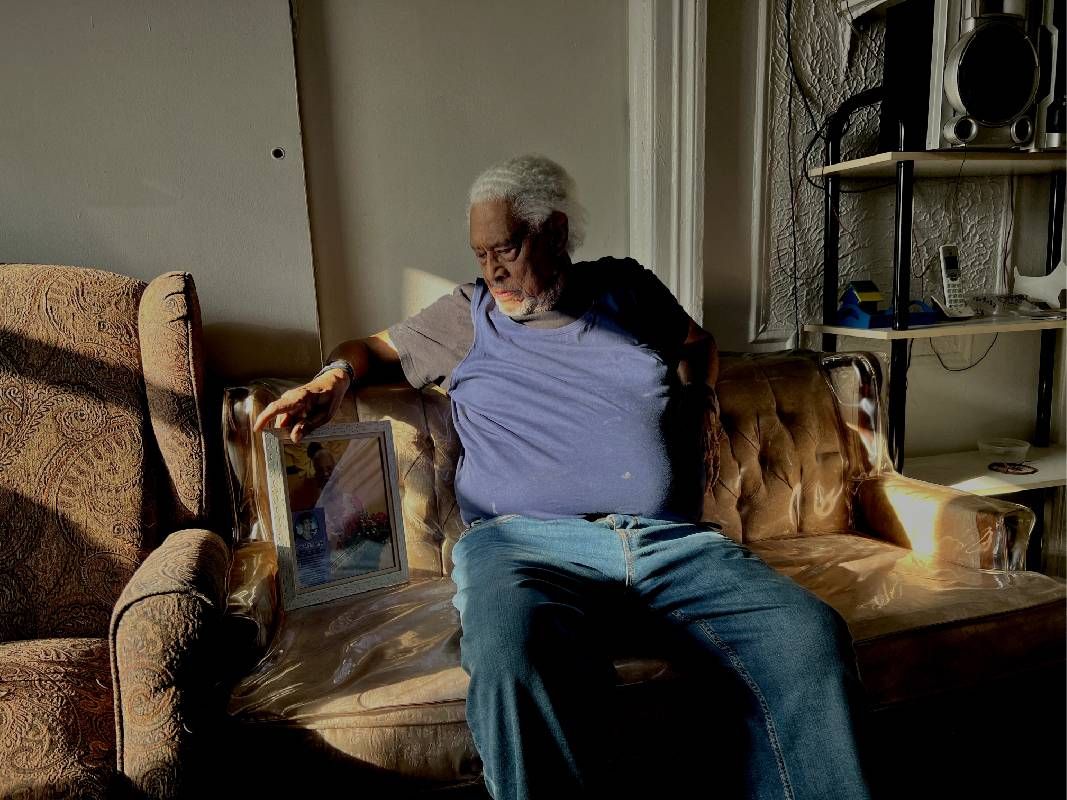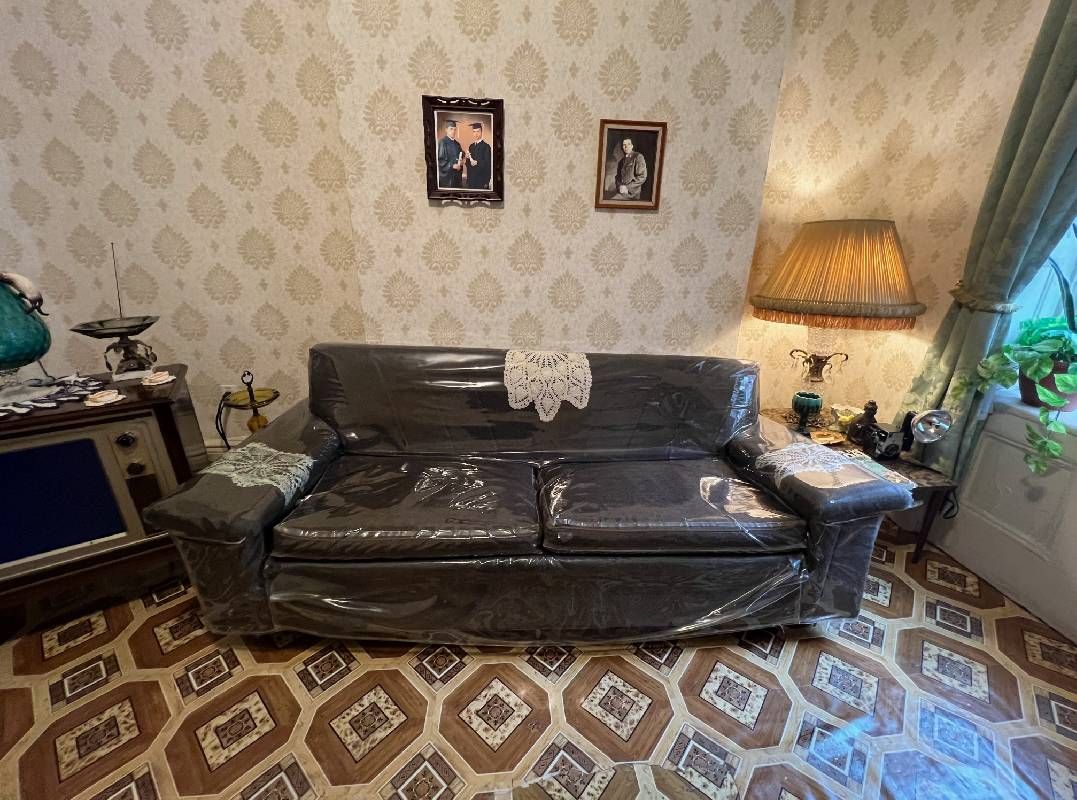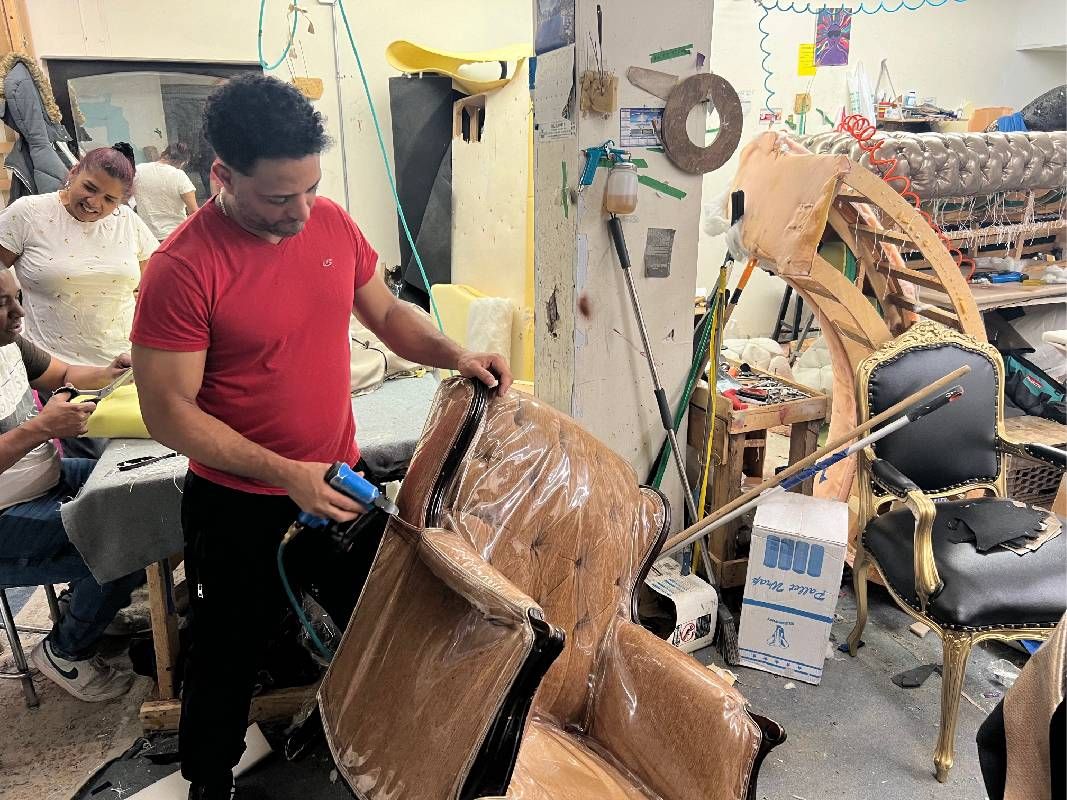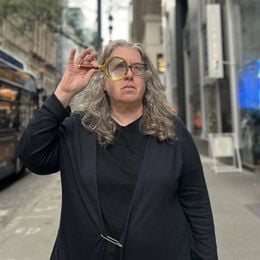An Elegy to Plastic Slipcovers
When couch shopping was an event, and the plastic that covered it, a status symbol

A gentle indentation marks the spot where Rosa Peña sat enthralled, clutching the hand of her husband, Leo Sánchez, as they watched the melodrama of telenovelas on a plastic slipcovered loveseat in their New York City apartment.
A large rectangular etched mirror reflected them back against chalky white painted walls in their short living room that overlooks the street. A combative window shade lets in sunlight that reflects off the shiny plastic and forces Sánchez to squint. At 90, his sturdy frame and thick white hair make him look 30 years younger.
Sánchez once drove a truck delivering caskets to funeral homes not long after he arrived from Santiago in the Dominican Republic in 1962. His wife died in 2019. They sat cheek to cheek for 32 years on a couch embalmed in vinyl.
Back then, shopping for a couch was an event ... a thick layer of plastic was installed on couches before it arrived from the local furniture store
"Sometimes," Sánchez said, the plastic creaking as he showed her portrait. "I think she's still here next to me."
Peña and Sánchez were a wave of furniture owners from coast to coast, like my great-aunt Esther Attas Nachman of the Bronx, who owned sofas and loveseats covered in the variations of beige and gold fabric during the 1960s through the 1980s and some even into the 21st century.
Back then, shopping for a couch was an event. The perfect color, the perfect fit, the most comfortable and the best price were debated and negotiated. Newspaper, television and radio advertisements promoted the benefits of protecting and preserving furniture from food, children and pets. And then a thick layer of plastic was installed on couches before it arrived from the local furniture store or measured in living rooms by men from nearby upholstery shops.
Plastic Wrapped
After my great-aunt transitioned to a nursing home, one chair and a couch long enough for four people rode by van to the home of the Newswomen's Club of New York in Gramercy Park. Once detached from their plastic coverings, the gold fabric looked as fresh as the day it left the store on the Grand Concourse. The couch outlived my aunt by a good 20 years before breaking down under the strain of too many journalists.
I wondered, who else endured plastic slipcovers?
The chair celebrates its 75th birthday or so this year but like Leo Sánchez, it looks at least a generation younger. Its shape and fabric brought me back to humid summers in a stifling apartment, the back of my thighs damp and sticking to the plastic.
Windows closed. Plastic Venetian blinds shuttered so neighbors couldn't peep in. Plastic flowers wilting like me in a vase on the windowsill. Perspiration dripped down my back. I peeled myself off of the couch like Colorforms with a suctioning sound. Auntie Esther wiped down the couch and chairs with a damp sponge or a spritz of Windex. As I sat in the chair this past winter, I wondered, who else endured plastic slipcovers?
The actress Joan Crawford's guests did. Obsessed with cleanliness, she took plastic slipcovers to another level. Her decorator, Carleton Varney, noted, "There were more objects wrapped in plastic in Joan's apartment than in an A&P meat counter."
Outlived by the Furniture
Martin Englisher, 67, grew up in northern Manhattan. He recalls sitting shiva (the Jewish period of mourning) for his 51-year-old aunt in her Inwood apartment.
"Everyone was sitting on plastic slipcovers and I said, 'Imagine. She never had her own legs and tuchus (rear end) touch her own couch because she protected the couch which outlasted her.' This made me feel really sad. It was like it had a priceless value when she could have just enjoyed it. I always thought it was kind of a Jewish cultural thing. But over time I've learned that a lot of people's culture was to overprotect their goods."

His parents also covered their couch in plastic.
"We had to sit on plastic which was highly uncomfortable," Englisher said. "Nobody ever questioned that. We all kind of tolerated it as if it was a totally normal thing."
His parents finally removed the plastic shield when they moved on up to the Bronx. Englisher was 20 years old.
"They said that maybe I was right, that sitting on it wearing it out was a better thing, that we should live to wear it out rather than not ever sit on our own items," he said.
Englisher thought he would never see a plastic covered couch again.
But when he moved into his office as chief executive officer of the YM & YWHA of Washington Heights & Inwood in 1980, nesting against the wall was — a couch with the dreaded plastic slipcovers. Out it went.
Angelica Spanos Deoudes, 36, a communications consultant who lives in northern Virginia, also grew up with the despised plastic.
"It was a matter of preserving things and taking care of things."
"It's one of nostalgia being from a Greek family," she recalled, "Every piece of furniture was completely covered in plastic."
The couch was a symbol of immigrant success. "My grandparents worked really hard and it was really expensive," she said. "You couldn't go out and buy a new one."
With two toddlers, she's considering becoming a third generation plastic slipcover owner.
"It's not an impossibility," she said. "They are very practical."
Josephine Boninti née Licari, a former educator, was born in 1946 and grew up in an Italian household in Brooklyn with her parents and grandparents.
"My grandparents decided on a French provincial with beautiful covers. Marie Antoinette would never have bought this furniture," she said. "It was a matter of preserving things and taking care of things."
The couch and its covers lasted about six or seven years until the family moved to Valley Stream, Long Island and purchased new furniture, minus the plastic.
A Symbol of Success
The plastic covered couch in Juana María Lopez's Washington Heights living room was an emblem of her success. It was her most prized possession, said her daughter, Maria Lizardo, 56. Her mother, born and raised in the Dominican Republic, worked as a tenant organizer.
"My mother wanted to protect the furniture. The couch had a Victorian frame with brocade embroidered on it. For her, it was about status," Lizardo said, executive director of the Northern Manhattan Improvement Corporation. "It was something that she worked really hard to buy. She paid for it in cash. She didn't owe. It was — 'Look. I've made it. I've bought this expensive sofa and I'm going to protect it. I don't care if it's 100 degrees. You sit your ass on it.' She grew up with nothing. That sofa meant everything to her."

In Mumbai, India, Sunita Deshpande, 62, covers her couch, dining room table and chairs in plastic when traveling to prevent dust from attaching to her furniture.
"My mom doesn't use them that often now because she has someone coming in to clean everyday (labor in India is cheap and convenient), but if she's visiting me for two to three months she'll cover furniture," said her daughter Srushti Hebbar who lives in New York City. "We've always lived in an apartment, and a lot of our friends and relatives use slipcovers, too. It's just a sustainable and affordable mindset to make furniture last forever. No one in India replaces things as often as they do here. I still have the same couch from my childhood," she said. "It's been 25 years."
Blanca Delgado, 76, born in Puerto Rico, now lives on the Lower East Side. "Every friend that I met and went to their house had plastic slipcovers. So when I got my first piece of furniture, the men at the store said, 'You're going to get plastic.' The plastic was horrible. Horrible. In the summer? Worse! You got stuck," she said. "And you had to get up. I didn't like it at all. But everybody had them. So I figured why not? Everybody had the same furniture because they all went to the same store."

For Anna Wirts, her three piece couch, a hand-me-down from her aunt, traveled on an interstate journey. When Wirts, one of a few Black sweater and hand models in the 1950s, now 87, moved from a two bedroom apartment in the South Bronx to a three bedroom house in Fayetteville, North Carolina, her couch was the most important piece of furniture on the moving truck. Forty years later, she's still sitting on it, still with the same plastic custom made slipcovers.
"With five children, I didn't want to ruin the couch," she said.
"A lot of parties have sat on that couch, including family reunions of over 150 people," her daughter Renee said. "That's thousands of behinds. The couch will always be in the family. It may outlive me. It looks like a museum."
And yes, there is one in a museum. Visitors to New York City's Tenement Museum can experience the sensation. A couch is part of its permanent collection, a recreation of the living room of Ramonita Rivera Saez from Puerto Rico who lived in the building from 1964 through 2011.
The Perils of Plastic
Not everyone is fond of plastic. Nora Sheung hates them. Now 71, she was born in Hong Kong. She sewed her own fabric slipcovers by attaching two flat sheets together.
"A sofa was a luxury," she said. "I don't believe in plastic. I wanted to feel the texture of the fabric."

Karen Erickson, 69, president of Slipcover America, a network of slipcover makers, offers fabric slipcovers made to order. She recalled a green brocade couch and cushions with fringe covered in plastic when visiting her Dutch grandmother in Glendale, California.
"It represented protecting the furniture," she said. "I never saw it off. You could wipe it down. We never wanted to sit on it."
While slipcovers have been covering furniture since at least the 17th century, the trend has moved towards purchasing less expensive furniture that can be easily replaced and slipcovers that can be tossed into the washing machine. Fabric slipcovers can be purchased for as little as $25 on Amazon and on Chewy with names such as Molly Mutt and FurHaven.
"I don't believe in plastic. I wanted to feel the texture of the fabric."
Today, the cost of fabric and sewing custom slipcovers, Erickson said, exceeds the cost of the sofa.
"You're making a garment to fit the furniture," she said. "It can cost anywhere from $700 to $1,000 with the price dependent on where you live and who you're working with."
Edward Ramirez, 43, the owner of Ramirez Upholstery on Broadway in New York City, is one of the few upholstery stores left in New York City. He sells maybe one or two plastic slipcovers a month to customers over the age of 60.
"They're the only ones who want them. I don't like them," he said. "I like to feel the fabric."
When plastic slipcovers were discarded after they turned yellow and brittle from heat or when removed, they wound up in the trash. They were once burned in incinerators. When New York City banned the burning of garbage via incinerators in 1993, trash was then transported to Staten Island's Freshkills landfill.

The detritus of plastic slipcovers and other garbage produced methane gas and millions of gallons of toxins which seeped into groundwater, according to the New York City Sanitation Department. Freshkills was closed in 2001 after 50 years. Now garbage is shipped out of state. Plastic slipcovers are not considered recyclable and can take centuries to decompose. So my great-aunt's slipcovers are still with us. Somewhere.
But it was left to one Brooklyn house cat to rebel against them. I still remember the story. Forbidden from curling up on his owner's beloved couch, Beeper executed his revenge while home alone one weekend. With one sharp and intentional swipe, he sliced open the plastic slipcover with his claw and marked his displeasure by using the opening as a litter box. Eyes glinting with triumph, Beeper sat on the couch and awaited his family's return. Florence, his owner, admired his critical thinking skills.
"What a smart cat," she said.
She and her teenage son scrubbed the couch and applied layers of clear masking tape to cover Beeper's savage destruction. Florence, her son, and now the cat sat together on the couch watching soap operas. I'm sad to report that Beeper has gone on to his glory. So have the plastic slipcovers.


